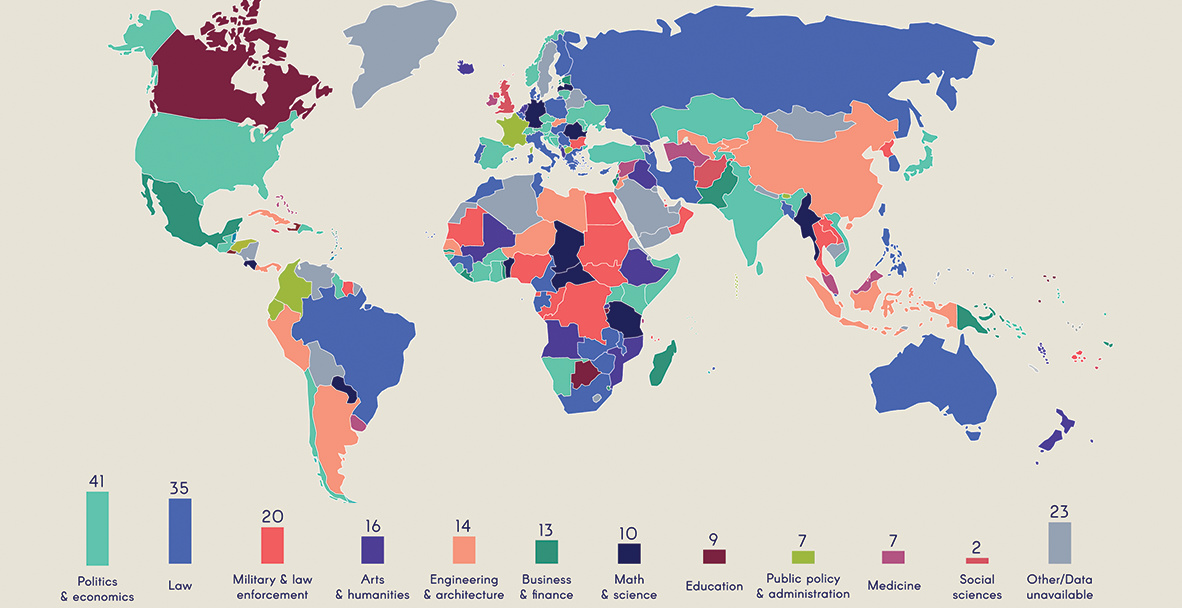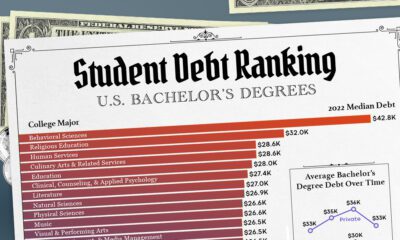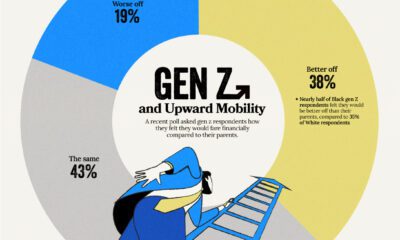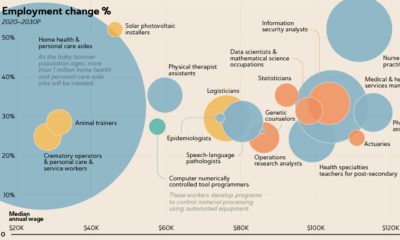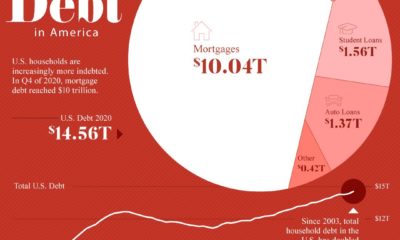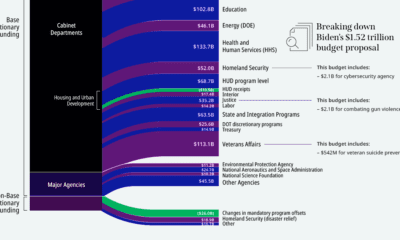Politics
What Did World Leaders Study at School?
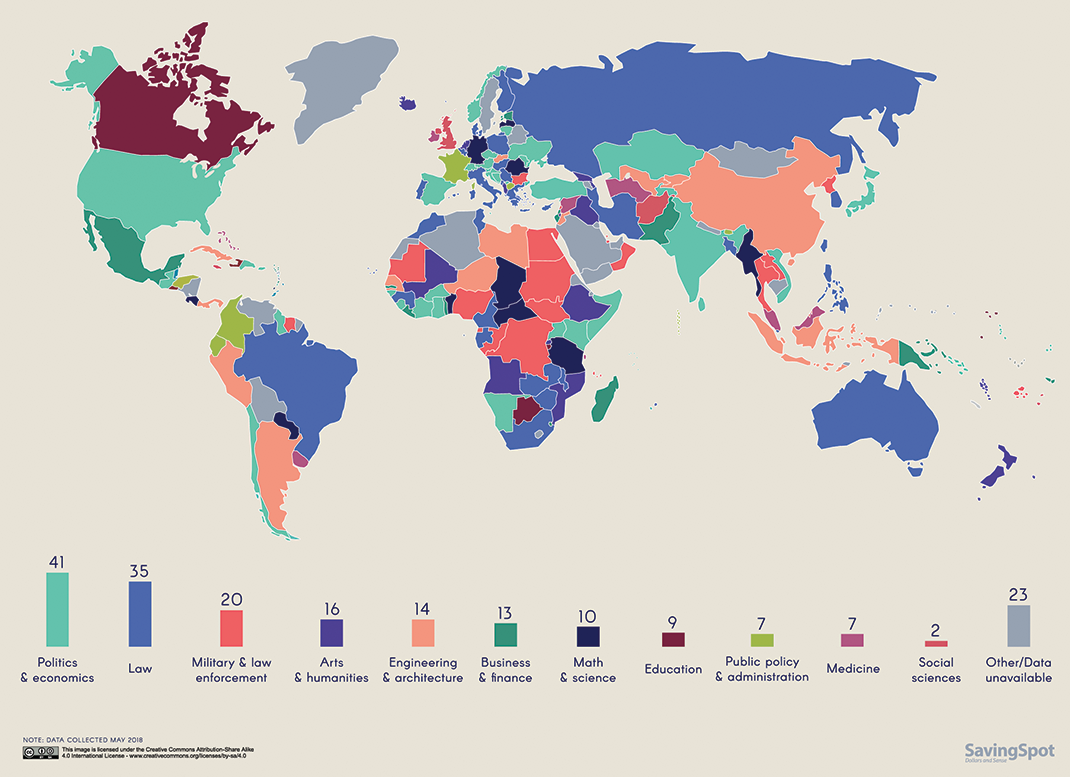
What Did World Leaders Study at School?
When it comes to the extremely challenging job of running a nation, a university education can help in setting up a leader for success. The vast majority of heads of government have some sort of post-secondary education – 83%, in fact – but their areas of study vary greatly.
Some leaders, like Alain Berset of Switzerland, specifically studied political science or law in university. Other leaders, such as Paraguayan president, Horacio Cartes, took a more roundabout path to the top, having studied aviation mechanics in the United States.
The following maps, from SavingSpot, are an informative look at what national leaders around the world studied in school.
Note: Hover over the maps to learn about leaders and their educational background.
North America
Donald Trump: America’s president holds a Bachelor of Science degree in Economics from the University of Pennsylvania Wharton School of Business.
Justin Trudeau: Canada’s prime minister holds two degrees: a Bachelor of Arts in Literature from McGill University, and a Bachelor of Education from the University of British Columbia.
Enrique Peña Nieto: Mexico’s president holds a law degree from Universidad Panamerica, and an MBA from the Monterrey Institute of Technology.
Europe
Angela Merkel: Germany’s chancellor has a heavy-hitting educational background. Merkel was educated at Karl Marx University, in Leipzig, where she studied physics from 1973 to 1978. She was awarded a doctorate for her thesis on quantum chemistry in 1986, and was recognized for her proficiency in Russian and mathematics.
Emmanuel Macron: The French president studied philosophy at the University of Paris-Ouest Nanterre La Défense. As well, Macron obtained a master’s degree in public affairs at the Paris Institute of Political Studies.
Stefan Löfven: Sweden’s prime minister took a more unconventional path to government. After completing military service in the Swedish Air Force, Löfven became a welder and subsequently a union representative. Eventually, Löfven became the first chairman of IF Metall, a newly formed trade union representing over 300,000 workers.
Asia
Vladimir Putin: Before joining the KGB in 1975, Putin studied Law at the Leningrad State University (now Saint Petersburg State University).
Xi Jinping: Xi studied chemical engineering at Beijing’s prestigious Tsinghua University. During this time, China was fully immersed in the Cultural Revolution. Xi studied as a “Worker-Peasant-Soldier student”, which included blocks of time spent doing farm work and studying Marxism–Leninism–Mao Zedong thought.
Africa
John Magufuli: Tanzania’s president has an extensive educational background, earning masters and doctorate degrees in chemistry from The University of Dar es Salaam.
Uhuru Kenyatta: The Kenyan president studied economics, political science, and government at Amherst College in Massachusetts.
South America
Michel Temer: Brazil’s president attended the Law School of the University of São Paulo, and later completed a doctorate in public law at the Pontifical Catholic University of São Paulo.
Mauricio Macri: Before becoming an analyst at SIDECO Americana, Argentina’s president received a bachelor’s degree in civil engineering from the Pontifical Catholic University of Argentina. He also attended Columbia Business School, the Wharton School of the University of Pennsylvania, and the Universidad del CEMA in Buenos Aires.
Oceania
Malcolm Turnbull: Australia’s prime minister graduated from the University of Sydney with a Bachelor of Arts and a Bachelor of Laws, before earning a Bachelor of Civil Law at Brasenose College, Oxford.
Enele Sopoaga: The prime minister of the tiny island nation of Tuvalu is one of many world leaders educated in the United Kingdom. Sopoaga earned a Certificate in Diplomatic Studies from Oxford University, and a master’s degree from the University of Sussex.
Economy
The Bloc Effect: International Trade with Geopolitical Allies on the Rise
Rising geopolitical tensions are shaping the future of international trade, but what is the effect on trading among G7 and BRICS countries?

The Bloc Effect: International Trade with Allies on the Rise
International trade has become increasingly fragmented over the last five years as countries have shifted to trading more with their geopolitical allies.
This graphic from The Hinrich Foundation, the first in a three-part series covering the future of trade, provides visual context to the growing divide in trade in G7 and pre-expansion BRICS countries, which are used as proxies for geopolitical blocs.
Trade Shifts in G7 and BRICS Countries
This analysis uses IMF data to examine differences in shares of exports within and between trading blocs from 2018 to 2023. For example, we looked at the percentage of China’s exports with other BRICS members as well as with G7 members to see how these proportions shifted in percentage points (pp) over time.
Countries traded nearly $270 billion more with allies in 2023 compared to 2018. This shift came at the expense of trade with rival blocs, which saw a decline of $314 billion.
Country Change in Exports Within Bloc (pp) Change in Exports With Other Bloc (pp)
🇮🇳 India 0.0 3.9
🇷🇺 Russia 0.7 -3.8
🇮🇹 Italy 0.8 -0.7
🇨🇦 Canada 0.9 -0.7
🇫🇷 France 1.0 -1.1
🇪🇺 EU 1.1 -1.5
🇩🇪 Germany 1.4 -2.1
🇿🇦 South Africa 1.5 1.5
🇺🇸 U.S. 1.6 -0.4
🇯🇵 Japan 2.0 -1.7
🇨🇳 China 2.1 -5.2
🇧🇷 Brazil 3.7 -3.3
🇬🇧 UK 10.2 0.5
All shifts reported are in percentage points. For example, the EU saw its share of exports to G7 countries rise from 74.3% in 2018 to 75.4% in 2023, which equates to a 1.1 percentage point increase.
The UK saw the largest uptick in trading with other countries within the G7 (+10.2 percentage points), namely the EU, as the post-Brexit trade slump to the region recovered.
Meanwhile, the U.S.-China trade dispute caused China’s share of exports to the G7 to fall by 5.2 percentage points from 2018 to 2023, the largest decline in our sample set. In fact, partly as a result of the conflict, the U.S. has by far the highest number of harmful tariffs in place.
The Russia-Ukraine War and ensuing sanctions by the West contributed to Russia’s share of exports to the G7 falling by 3.8 percentage points over the same timeframe.
India, South Africa, and the UK bucked the trend and continued to witness advances in exports with the opposing bloc.
Average Trade Shifts of G7 and BRICS Blocs
Though results varied significantly on a country-by-country basis, the broader trend towards favoring geopolitical allies in international trade is clear.
Bloc Change in Exports Within Bloc (pp) Change in Exports With Other Bloc (pp)
Average 2.1 -1.1
BRICS 1.6 -1.4
G7 incl. EU 2.4 -1.0
Overall, BRICS countries saw a larger shift away from exports with the other bloc, while for G7 countries the shift within their own bloc was more pronounced. This implies that though BRICS countries are trading less with the G7, they are relying more on trade partners outside their bloc to make up for the lost G7 share.
A Global Shift in International Trade and Geopolitical Proximity
The movement towards strengthening trade relations based on geopolitical proximity is a global trend.
The United Nations categorizes countries along a scale of geopolitical proximity based on UN voting records.
According to the organization’s analysis, international trade between geopolitically close countries rose from the first quarter of 2022 (when Russia first invaded Ukraine) to the third quarter of 2023 by over 6%. Conversely, trade with geopolitically distant countries declined.
The second piece in this series will explore China’s gradual move away from using the U.S. dollar in trade settlements.

Visit the Hinrich Foundation to learn more about the future of geopolitical trade

-

 Economy2 days ago
Economy2 days agoEconomic Growth Forecasts for G7 and BRICS Countries in 2024
The IMF has released its economic growth forecasts for 2024. How do the G7 and BRICS countries compare?
-

 United States2 weeks ago
United States2 weeks agoRanked: The Largest U.S. Corporations by Number of Employees
We visualized the top U.S. companies by employees, revealing the massive scale of retailers like Walmart, Target, and Home Depot.
-

 Economy2 weeks ago
Economy2 weeks agoWhere U.S. Inflation Hit the Hardest in March 2024
We visualized product categories that saw the highest % increase in price due to U.S. inflation as of March 2024.
-

 Economy1 month ago
Economy1 month agoG20 Inflation Rates: Feb 2024 vs COVID Peak
We visualize inflation rates across G20 countries as of Feb 2024, in the context of their COVID-19 pandemic peak.
-

 Economy1 month ago
Economy1 month agoMapped: Unemployment Claims by State
This visual heatmap of unemployment claims by state highlights New York, California, and Alaska leading the country by a wide margin.
-

 Economy2 months ago
Economy2 months agoConfidence in the Global Economy, by Country
Will the global economy be stronger in 2024 than in 2023?
-

 Debt1 week ago
Debt1 week agoHow Debt-to-GDP Ratios Have Changed Since 2000
-

 Markets2 weeks ago
Markets2 weeks agoRanked: The World’s Top Flight Routes, by Revenue
-

 Demographics2 weeks ago
Demographics2 weeks agoPopulation Projections: The World’s 6 Largest Countries in 2075
-

 Markets2 weeks ago
Markets2 weeks agoThe Top 10 States by Real GDP Growth in 2023
-

 Demographics2 weeks ago
Demographics2 weeks agoThe Smallest Gender Wage Gaps in OECD Countries
-

 Economy2 weeks ago
Economy2 weeks agoWhere U.S. Inflation Hit the Hardest in March 2024
-

 Green2 weeks ago
Green2 weeks agoTop Countries By Forest Growth Since 2001
-

 United States2 weeks ago
United States2 weeks agoRanked: The Largest U.S. Corporations by Number of Employees

